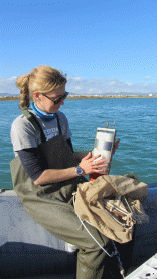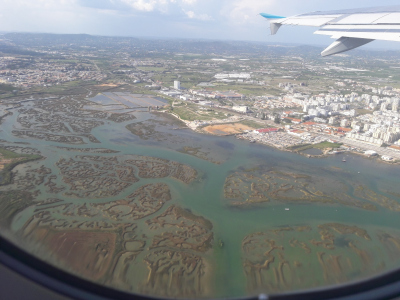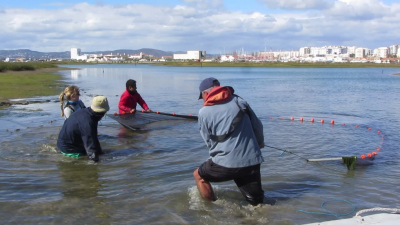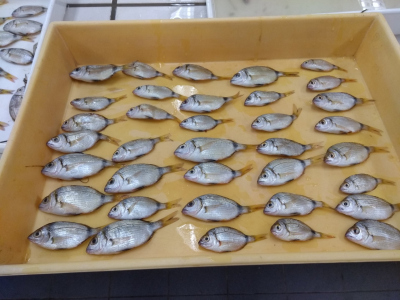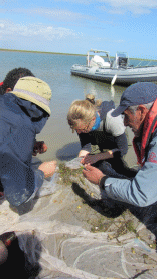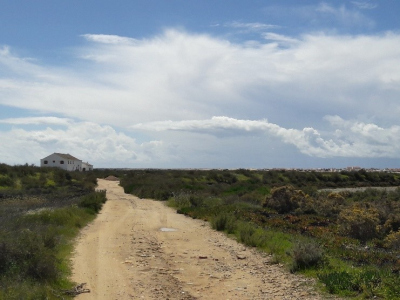- Graduate School GLOMAR
- PhD student reports
- Field Campaigns
- Carolin Müller
Carolin Müller
Report of GLOMAR PhD student Carolin Müller about her Field Campaigns in Faro, Portugal 2018
In mid-March 2018, I packed my bags to start with the first out of three consecutive fieldwork campaigns to be conducted this year. To collect samples and run experiments for my PhD project, in which I investigate the impact of microplastic uptake for juvenile fish condition, my path led me back to Faro (Portugal) and its unique Ria Formosa lagoon where I had already carried out the study for my Master’s thesis four years ago. At the Centro de Ciências do Mar of the Universidade do Algarve, I was lucky to take up my small network of dedicated and experienced marine biologists I met in 2014 and whom I can count on for my PhD research.
In my current project, I combine findings from empirical assessments and experimental approaches: an ichthyoplankton survey off the coast of Western Africa as part of the AWA project (https://www.leibniz-zmt.de/en/research/research-projects/awa.html) on board the German RV Meteor (from August 2016) is complemented by the field study in the Ria Formosa lagoon and feeding experiments with juvenile fish. This combination enables me to investigate the impact of habitat quality parameters and microplastic uptake on growth and survival of early life stages of commercially important fish species in relation to different temporal and spatial scales.
The selection of the Ria Formosa lagoon as a comparative site for this investigation was based on the following considerations (wait for it, there are more reasons beyond the Algarve being scenic, sunny and serving the tastiest espresso):
The Ria Formosa is a semi-protected coastal lagoon system, comprising unique biological, ecological and hydrological traits. The diverse ichthyofauna - i.e. the fishy part of the lagoons’ inhabitants - is known to comprise 112 different species which can be categorized as either occasional, migratory or resident. Most of the non-resident species are of high commercial value such as seabreams (Sparidae which is the fish family I focus on), sardines and sea bass. The majority of these species migrates to the adjacent coastal waters in the late autumn or winter. Therefore the Ria Formosa is considered an important nursery for many commercial species from March to October. Accounting for the high spatial diversity in terms of abiotic factors, macro- and microhabitats as well as invertebrate and vertebrate communities, we hypothesized that juvenile seabreams using the Ria kindergarten and showing a high site fidelity, encounter a gradient of habitat quality and pollution from inner to outer parts of the lagoon.
The aim of my initial stay in Faro was threefold: firstly, in this very dynamic ecosystem, I had to choose the appropriate samplings sites in the inner, middle and outer part of the lagoon. Luckily, I could rely on the experience of my colleagues – instead of searching the entire lagoon for sites, we purposefully headed for a number of pre-selected spots which had proven to be good sampling sites in the past. Out of these, we selected several at the inner part of the lagoon, e.g. close to the yacht harbour of Faro, in the middle and at the outer part of the Ria e.g. close to an outlet to the Atlantic Ocean. Secondly, we conducted a fortnightly sampling of all stations. Not only did we pick up juvenile seabream, to investigate their growth rate, stomach content and condition, we also sampled for zooplankton and benthos, collected data on temperature, salinity, oxygen, habitat vegetation, sediment type and so on. This sampling design and the aforementioned stations were kept equal in the fieldwork campaigns in summer (July & August 2018) and fall (October & November 2018). By this seasonal monitoring, we assess the entire kindergarten time of juvenile seabream.
Video: Sampling of seabrams in the Ria Formosa lagoon near the city of Faro, Portugal
We were already quite busy with these tasks in spring, but wait, did I mention three aims? Indeed, at Ramalhete, the Marine Biology Fieldwork Station, I ran feeding experiments on the potential microplastic uptake by juvenile White Seabream (Diplodus sargus).
The novel approach of this experiment in spring was to test juvenile seabream for microplastic uptake under particle densities resembling natural conditions – most of the previous studies conducted in the past applied densities exceeding what is found in nature by far. The results of the experiments will complement the findings from the field campaigns in order to assess the impacts of microplastic on the growth and survival of juvenile seabream in coastal ecosystems.
Altogether, I was allowed to spent 18 busy weeks of the year 2018 in Faro, doing fieldwork, experiments, labwork, giving practical courses for Master students, supervising student projects, learning new methods (fancy RNA:DNA analysis for instance), doing more fieldwork – and also enjoying the stunning nature of the Algarve during spring, summer and fall J All of my dear colleagues at CCMAR deserve special thanks and greetings for their continuous support and for turning my ‘work’ into a lot of fun!
What’s left of these exciting fieldwork and labwork campaigns? Boxes full of samples which are waiting to be analysed – zooplankton, benthos and seabream to spend the cold and rainy days of winter in Germany with.



